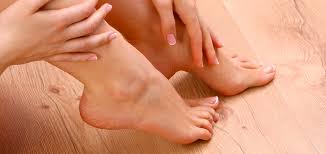
As the warmer months approach, sandal season is officially upon us. However, my feet are not quite ready to make their debut. After a long winter of wearing thick socks and heavy boots, they’ve certainly taken a toll. The soles, in particular, have become dry and cracked, making them feel rough to the touch. It’s not the most charming thing to admit, but no matter how many times I scrub my feet with a file or rub lotion on them, the dry patches persist. One of the most unpleasant sensations is when my feet get caught in the sheets at night, feeling rough against the soft fabric – it’s definitely not a feeling I enjoy.
It turns out, I’m not the only one facing this problem. On social media platforms like TikTok, the issue of dry, cracked feet has gained a massive following, with over 5.7 billion views dedicated to the topic. The hashtags #footcare and #dryfeet alone have over 1.2 billion and 129 million views, respectively. TikTok is filled with users sharing tips and tricks for tackling this issue, offering a variety of hacks to make our feet feel soft and smooth again. One trend that particularly caught my attention involves using glycolic acid, a popular skincare ingredient known for its exfoliating properties.
The hack was popularized by TikTok user @calistatee, who demonstrated how she used The Ordinary’s 7% Glycolic Acid Toner to tackle cracked skin on her feet. The video quickly went viral, racking up hundreds of thousands of likes as she showed followers how easy and effective it was to transform dry feet into soft, glowing ones. Her method was simple: pour a small amount of the glycolic acid toner onto a cotton pad, rub it into the feet, and then apply a moisturizer before slipping on a pair of socks. After just two hours, she noticed a significant difference, and her feet felt softer than they had in months. In her words, she didn’t expect her feet to “glow,” but the results were impressive.
Even The Ordinary’s CEO and co-founder, Nicola Kilner, chimed in, saying she tried the method herself and found it worked wonders. Intrigued by the viral trend, I decided to take it a step further by consulting with a skincare expert to determine if this glycolic acid pedicure really lived up to the hype.
Dr. Parisha Acharya, a cosmetic physician, explained that glycolic acid is an alpha hydroxy acid (AHA) that chemically exfoliates the skin by breaking the bonds between dead skin cells. “It helps to remove dead skin issues like calluses and softens the skin,” she explained. As an exfoliant, glycolic acid is widely used in skincare products to improve skin texture and radiance. It works by sloughing off the top layer of dead skin, leaving behind fresh, smooth skin underneath. Given its exfoliating properties, it made sense to apply it to the thick, calloused skin on our feet, which is often subjected to friction from shoes and walking.
Dermatologist Dr. Anjali Mahto also weighed in on the viral trend, discussing how glycolic acid could benefit dry feet. “If you asked me if glycolic acid would help with dry feet, in theory, I would think so,” she said in an Instagram Live session. “It’s an exfoliating acid, and if you have a lot of hard, dead skin on your feet, a little glycolic acid might help.” She also mentioned that the cuticles on the soles of our feet are particularly thick, so using glycolic acid could assist in breaking down the build-up of dead skin. If you’ve developed a thick layer of calluses, glycolic acid might be a helpful tool in softening and breaking it down.
Dr. Acharya recommends using glycolic acid once or twice a week for effective exfoliation, while incorporating a nourishing balm on other nights to maintain hydration. This combination, she said, will leave you ready for sandal season in no time. While both skincare experts and TikTok users seemed to be on board with glycolic acid’s potential for treating dry, cracked feet, I still wondered if this method would work for me, especially given that I already had a bottle of The Ordinary’s glycolic acid toner on hand.
I have to admit, I’ve had some issues with glycolic acid in the past. When applied to my sensitive facial skin, I’ve experienced irritation and redness, and the toner is definitely too strong for me to use regularly on my face. Still, I thought it might be a perfect exfoliant for my feet, so I decided to give it a try.
For my experiment, I started by saturating a cotton pad with The Ordinary’s 7% Glycolic Acid Toner and gently rubbing it into the dry, cracked skin on my feet. I then applied a thick layer of Flexitol Overnight Foot Cream, which is known for its hydrating and skin-softening properties. Once I was done, I slipped on a pair of thick socks and went to bed, hoping the extra hours of sleep would give the glycolic acid time to work its magic. The next morning, I was pleasantly surprised by the results. My feet felt less rough, and the dry, flaky skin had significantly reduced. However, I wasn’t ready to call it a success just yet, so I continued this technique for the next few nights to give my feet ample time to benefit from the glycolic acid treatment.
By the end of the week, my feet were noticeably softer, and the dry, cracked skin that had plagued me for months was now gone. While there were still some minor wrinkles on the soles (which I blame on the heavy boots I wore during the winter months), my feet felt smoother and much more comfortable than they had in a long time. Dr. Mahto had mentioned that the skin on our feet is thicker than on other parts of our body, which is why I didn’t experience any irritation or burning while using glycolic acid. However, as with any active skincare ingredient, it’s important to take precautions.
Dr. Acharya emphasized the importance of avoiding glycolic acid on broken or irritated skin, especially if your heels are severely cracked. If your feet are in that condition, she recommends a gentler approach: soaking your feet in warm water at night to soften the skin, then applying a nourishing balm before covering your feet with bamboo socks. In the morning, you can gently massage any hardened skin with an exfoliating mitt or pumice stone to remove dead skin cells.
One of the most appealing aspects of this foot care method is its accessibility. You don’t need to purchase expensive products to achieve smooth, healthy feet. In fact, any exfoliating toner you have at home — even one meant for the face — can be used on your feet. If you don’t have glycolic acid, there are other exfoliating products that may work just as well. For example, CeraVe SA Renewal Foot Cream, which contains salicylic acid, is another great option for treating dry, cracked feet. This product also includes ceramides to help restore the skin’s natural barrier. Another good option is O’Keeffe’s Healthy Feet Exfoliating Moisturizing Foot Cream, which contains lactic acid, urea, and shea butter to help hydrate and exfoliate the skin.
Ultimately, while glycolic acid treatments worked wonders for me, they are not the only way to tackle dry feet. If you prefer to stick to more traditional foot care products, there are plenty of options available that can help nourish and soften the skin. However, if you’re looking for an effective exfoliating solution, glycolic acid may be a game-changer for your feet — just be sure to use it responsibly and follow up with plenty of moisture to keep your skin hydrated and healthy. So, with sandal season in full swing, my feet are now ready to shine, thanks to the help of glycolic acid and a little extra TLC.


